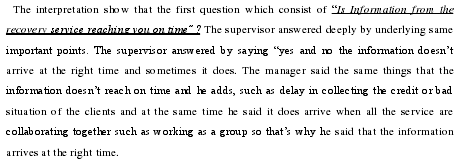Chapter1: General Introduction
1.1. Background
The requirements of the international economy impose many challenges for African businesses. Among these challenges, we have the challenge of growth and the challenge of better management. Faced with changes in the economic environment, companies must adapt successfully through proper investment policy and by the conquest of new markets. It is in a context of real trade and frequent turning of the economic cycle, that the company must continually adapt and develop its ability to anticipate.
Under these conditions, optimizing its relationship with its external partners and especially its client is positioned in the heart of the financial management and performance of the company. Indeed, competitiveness depends on it. The complexity of this relationship and the interest being shown it is based on this fact: that you approach for accounting or in terms of knowledge of the customer portfolio, customer credit is a risky investment, which is at the base of bankruptcies.
The performance of logistics companies lies in their ability to link management to best practices. Talking about companies in general means confronting the forces on the market, including suppliers and customers, and having the ability to manage and audit the internal operations of the company or the department. Here it is not very important to mention the suppliers in our research but rather to talk about the quality of the internal management and how the company manages to manage that. Lee et al. (2010) stated that since TQM is a business management strategy, it also improves the quality of organizational management, increases competitiveness and adds value to the customer as provides as well as a competitive advantage for organizations. This helps the company to manage their internal function and have better and strong strategy to avoid any risk in the management.
..........................
1.2Significance of the study
The results of the study will allow DCT management to identify the weakness of the established claims management policy. At the end of my cycle I will be able to give my report to DCT management so that they can renew their management and collection service procedures as well as this report, it will provide a good guide for improvements in the management of accounts receivable. The study helped me understand the policy and procedure for recovering client receivables for company, it is very important for each company and it allows the researcher to become familiar with the field. It improves the researcher's knowledge of aspects of data collection and analysis and also give new suggestions. The study will allow researchers to qualify for the PhD in finance and accounting.
A two-stage methodology was applied in this research. A mixture of both qualitative and quantitative methods was used to provide the necessary research results for triangulation to improve internal validity and to achieve a better understanding of the subject Perry (1998). The research methodology adopted in this research comprised the following stages:
.........................
CHAPTER 2: Literature Review
2.1. Management of account receivable
Having accounts receivables is both good and bad. It is good because it means that you have sales and customers. It is bad because it is cash that you don’t have now, and there is always a possibility that you won’t collect. When you offer credit terms to your customers, it is extremely important to have a system in place to manage your accounts receivable. The function of accounts receivable management emanate from its goals which is stated simply as setting out credit terms, selecting the customers, installing appropriate collection and monitoring system and financing receivables for maximizing the value of the firm, Hrishikes (2002). The first issue for the management of trade debtors is to decide whether to grant credit at all Arnold, (2005). However credit is inevitable. The global market runs on credit, goods and services are routinely delivered with the expectation that payment will be made according to the agreed payment terms Salek, (2005). If a firm decides that it is in its best interest to allow delayed payment then it needs to set up a system of rules and guidelines which will amount to a debtor policy Arnold, (2005).
Account receivable management directly impacts the profitability and the performance of the company, since it represents the sizable percentage of most firms’ assets. According to Lassegue, (2002), debt collection is defined as the failure of a creditor to obtain payment of the sum of money to the arrival of the agreed term. A company is related with two basis cash and credit, but the pressures of external environment (competitors) and customers situation constrain the company to offer credit, however the upswing of the credit leads to the establishment of Account Receivable, which represent the credit that have not been collected. As long as the customers is paying the money that he owes to the company, the company will receive cash otherwise a bad debt loss is incurred Pinches G, (1994).
........................
2.2. Credit Risk Analysis and Evaluation
The chief aim of debtors‟ management is to ensure minimum or optimum investment in accounts receivable and considerable reduction in bad debt losses. To achieve this, the financial manager should follow clear cut principles and procedures to evaluate the credit worthiness of the applicants regarding how much credit can be extended and for how long Periasamy, (2009). Granting credit is a journey, the success of which depends on the methodology applied to evaluate and to grant credit. The journey starts from the application for credit through acquisition of credit sales and ends at the time the debt is fully paid Clerke, (1999). Credit granting exist to facilitate sales but credit sales are pointless without due payment Morgan, (2002).
Credit analysis seeks to determine who will receive credit and under what conditions. For a continuing customer it is much easier because experience provides considerable information. For new customer credit analysis is obviously a tougher problem Weaver and Weston, (2008). As alternative sources of funds become costly and unavailable due to increasing lending rates, customers start to look at trade credit as a source of working capital. Current customers will request for extension of terms to stretch out their payments. When dealing with new customers, a firm might require making the following considerations when asked to extend credit to a troubled company. There can be a number of reasons why a formerly profitable company becomes unprofitable; insufficient sales, shrinking profit margins, excess costs or even poor credit and collection management. Determining what is going wrong is important in deciding whether or not to extend credit to such a company. Taking the following steps will help to get to the bottom of things; ask the customer face-to-face; if possible perform a site visit and speak to the owners and managers why the company is in difficulty.
............................
Chapter 3: the evidence from Doraleh Container Terminal………….…….25
3.1. DCT Background ............................... 25
3.2. The classification of customers ................ 26
Chapter 4: Research design……………………………………32
4.1. Data collection methods and techniques .............................. 32
4.1.1. Method .......................... 32
4.1.2. Techniques ......................... 33
Chapter 5: Case study Analysis………………………37
5.1. Case analysis ...................... 37
5.1.1. Treasury service interview interpretation .............. 37
5.1.2. Interpretation of interview for the financial director and chief accountant ............. 38
Chapter 5: Case study Analysis
5.1. Case analysis
5.1.1. Treasury service interview interpretation
Data analysis for the interview made on the treasury service, in this part a deep analysis is made through the interview method. Therefore, the analysis shows that all the respondents don’t answer in the same way. Means, the supervisor has some responses which are different compared to the responses of the Manager or CFO or the assistants and vice versa all answers are similar or complementary or different to each other. This is the first interpretation of the answers between the supervisor of treasury and the assistant (because in each service there is a supervisor and his assistant) and as noticed the answers are not the same but they were having the same idea.

......................
Chapter 6: Recommendations & Conclusion
According to AUBERT & al, (2004) zero risk doesn’t exist and in order to be able to manage the risks associated with the debt management process, Doraleh Container Terminal must take into account certain parameters and must put in place risk management systems. This is why, at the end of our analysis, we formulate recommendations that will improve the management process and also avoid cash shortages.
According to PIC (2009), "recovery is a stimulus payment, or out of court, performed by a supplier to its customers in arrears”. Trade receivables represents for the company a key asset whose good management requires diverse skills, the development of rigorous procedures and still very important human and financial investment. In order to avoid bounced check, first, the company should have a manual procedure in order to follow the procedures, step by step at the right time. Secondly, the staff should know about the procedures and how to deal with it and try to educate the customers about the procedures of debt credit. However, once the procedures are made now, they have to respect the duration of breaking off the activities and the raising. Means all the procedures whatever if the company is not using this action, they have to used to avoid receiving bounced check. By first, make the pressure on the client, uses face to face raise, sometimes one of the company managers should go to debtor office to discuss about the payment. It is very important to follow the procedures established in the management of outstanding debts. Given the importance of collection, we recommend that credit officers place special emphasis on home visitation and maintenance with the debtor client. We believe that permanent contact with the customer would put pressure on him and this will encourage him to repay the amount owed. Then finally, if any of these is not working now the company can use the court (jurisdiction) to get back its money.
reference(omitted)
